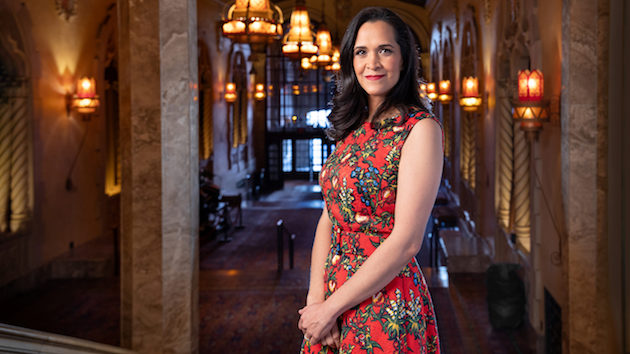
In December it was Three Decembers, a remarkable production directed for video and starring the superstar mezzo-soprano Susan Graham. That served as the wakeup call for any Bay Area opera watchers who had not been keeping track of Opera San José under its new boss, General Director Khori Dastoor. SFCV called the production “a holiday miracle,” and in a way, it really was. You don’t think of a venerable, but mid-sized, budget conscious opera company surging into the spotlight by bootstrapping their way into sophisticated video content. But there it is, still viewable.
Now it is Dastoor’s Love and Secrets: A Domestic Trilogy, three short one-acts that closely track couples and relationships in different stages, directed for video by Tara Branham, now streaming on the OSJ site. The trilogy is anchored by Ermanno Wolf-Ferrari’s delightful comedy The Secret of Susanna, starring Efraín Solís as Gil and Vanessa Becerra as Susanna, then Ned Rorem’s Four Dialogues, really a song cycle to poems by Frank O’Hara, starring Marnie Breckenridge and Carlos Enrique Santelli, and then Tom Cipullo’s The Husbands (libretto by William Carpenter) starring former SF Opera Adler Fellows Ashley Dixon and Eugene Brancoveanu.

When you sit down with her, it’s obvious that Dastoor is a great communicator who has thought deeply about what she’s doing and where the company is headed under her direction. She’s also a fearless truth-teller, which always makes for a fascinating conversation. Our talk about her forays into video production and what it means for Opera San José in the future was delightful, but also filled with details and lucid observations. It’s been lightly edited and condensed.
It seems like some of the tools that we developed to communicate with audiences in the pandemic are going to continue to be useful in the long transition to going back to theaters.
I feel sheepish that OSJ didn’t tackle digital content — short form content — before this pandemic. As someone who programs – and I’m always seeking out exciting projects and new repertoire — I realized that I was just looking at one very small sliver of what is out there, because of the confines of the room. It has to be successful in this context, it has to move this amount of inventory, it has to fit in with the obligations we have to our labor partners [and so on]. Coming up in that way of thinking you don’t even realize how narrow you’ve become in your buffet of options. So now, I’m so thrilled at not just the actual artistic merit of these kinds of projects, but also the proposition for how it disrupts the business model, how we can avoid this trajectory of pricing ourselves out of existence.
When large companies are only able to do things for a few hundred patrons in cars but the costs mount to these ridiculous levels, then who exactly is the customer? Who are we keeping in mind? Is it a very small group of large [money] donors and, if so, what happens to us the day after tomorrow? And I don’t say that monetizing digital content is easy, but for people who would say it’s not economically viable, I would say, “Well, how is a large production of Turandot economically viable? And why are we applying those standards?” We have perfected this one very specialized form of expression and become accustomed to a certain level of excellence, and that is very difficult to surrender. It’s very difficult to feel that you can be competitive against Netflix and HBO and these other enterprises who have been perfecting their medium.
Opera San José isn’t just about the patrons it’s about the artists and if these artists do not understand how to adapt what they do for a digital space, we will not be serving them well. That is a huge part of how they’re going to build their brand, how they’re going to identify work, how they’re going to engage with patrons, and how they’re going to create value for themselves in the years to come.
So yes, everything [in the digital production space] is not perfect, everything is not ready for induction into the Academy of Motion Picture Arts and Sciences, however ... I’m having all the emotion that I have at a full production and I’m shocked by it.
I don’t know whether opera had reckoned with how audiences had been moved, visually, by movies and TV, beyond the proscenium setup and the single point of view.
Yes, and even just trying to build a thrust [stage] you know, and we don’t have one of these really oppressive proscenium theaters that’s a big barn — I love the California Theatre for its intimacy and its warmth — but the minute you step even six inches onto a thrust, you lose the upper balcony. So how we create an immersive experience — “I had this vision for my Salome and we’d be in a gladiator ring, and everyone would feel like they were really in it!” — but the realities of obstructed view and physics were kind of coming back again and again.
I do think, though, that technology is the key to that as well. Because, in everybody’s pocket in the theater is a way, a key. I almost don’t care anymore where my physical body is. My brain and my emotional experience can be channeled onstage, in the lobby, as I’m arriving, when I receive my ticket. So we can blow what it is to be a ticket buyer wide open and think about the experience — when it might begin, when it might end — through the technology that has been developed, I might add, only blocks away from where we are doing these shows. The potential is limitless and I hope that the companies that created these technologies embrace the artistic applications and help us mine them, because we need that support and we need that investment from the tech community in order to really make progress.
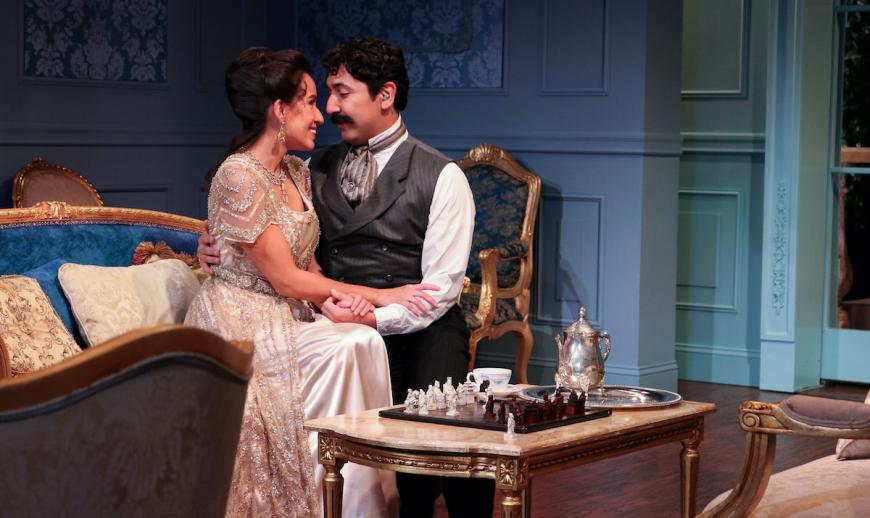
People like Yuval Sharon and James Darrah, who are directors who were distinctly “experimental,” became, during the pandemic, more accepted in the mainstream because they had ideas that they had tested about how you could present this artform in a nontraditional way. Is there a possibility, after this past year, of bringing in more nontraditional artists to produce opera?
These ideas aren’t new, but all of a sudden — and I learned this with Three Decembers — we had content while other places didn’t have content, so it made sense to make it available through licensing agreements and partnerships. So, again, back to the business model, what a co-production has traditionally been, how we’ve been able to help each other, how you really had to limit yourself to collaborations with companies who had both your budget size and the same size house, right? Because I couldn’t share a production with Houston Grand Opera because of the confines of our wing space. But now, all of a sudden, L.A. Opera and Opera San José can be creating work together. And it’s the same feeling of “Duh! What have we been doing, banging our heads against this wall?”
And yes, there were and will always be younger visionaries who are already piloting solutions and trying to bend the business. I hope opera takes away some key lessons.
One: the idea of nimbleness and not deciding three years in advance what art is going to be relevant in the moment. We have learned now that we can, if we are forced to, create programming in a much shorter time frame.
Two: accepting risk and failure as a part of what we do, instead of this idea, which stems from the proscenium, that we don’t want you to see this, we don’t want you to see that, we want you to see the perfect end result. That’s boring to me, it’s boring to people who don’t love opera, and it’s boring to people who have been going to opera their whole lives. They’d much rather sit by the stage manager’s console or tour the dressing rooms or watch the rehearsal.
I have patrons Zooming with us eight hours a day while we rehearse, because they love to see it all come together. And if the final show is just the cherry on top of the sundae, and they feel that they’ve left enriched, that they’ve learned something, then that’s the real value. And I’m so fortunate to be in Silicon Valley with a board that lives this way and thinks this way, and I think the moment calls for it because we’re really on a shrinking iceberg and we better figure it out.
It seems like Opera San José has taken a quantum leap in a year.
It’s a quantum leap but it’s not either/or. It’ll be Moby Dick and A Domestic Trilogy. And it’s my job to figure out who are the partners for the digital and who are the partners for the big operas that we all want to continue to see.
Do you think the audience can be the same?
No. There are certain diehard people who want to consume everything. I remember just a few weeks into my tenure I surveyed to find out who our subscribers are and I foolishly thought that they would be people who attended Symphony Silicon Valley and the museums, maybe TheaterWorks on occasion, and I was very wrong. They were San Francisco Opera subscribers, primarily. They had subscriptions at Opera Parallèle, at Livermore [Valley Opera], at West Edge, at West Bay ... I could not believe it. It seems as though some opera fans have this voracious appetite, but I think more and more will pivot toward standalone events and [we will pivot toward] welcoming an audience that is ready to give an opera a try once a year.
That will mean we will always do Carmen. I love Carmen, it’s one of the best operas ever written and I’m not here to cancel the things that work. But that’s a different patron than one who wants to watch [soprano] Marnie Breckenridge break my heart in 20 minutes, which is what she does in this shattering performance [of Rorem’s Four Dialogues], which I thought was sort of a flimsy Ned Rorem song cycle, but is an entire Traviata all in itself. So when you have artists like that, it’s so easy to say yes, because they deliver way above what your expectations could possibly be. And despite the limitations of budget — and we do have a very small budget — I feel like this is a world class experience and worth the 20 minutes.
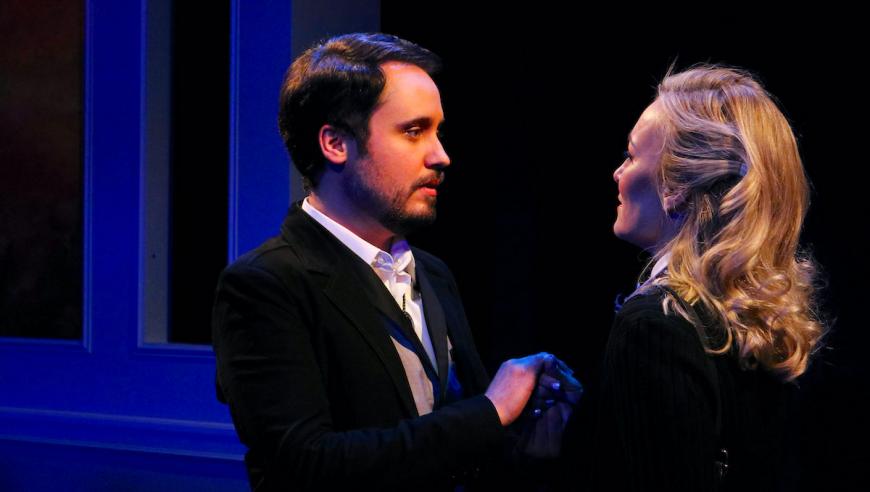
Did you find these pieces by looking for things that would fit your artists or did you think about the whole experience first? Or was there a piece you always wanted to do?
When this happened, it was like “OK, what’s possible? We can have 12 people in a room — no wait, we’re in orange [pandemic precaution tier], we can have 10, no we’re in purple ...” So we started with the realities of the situation.
And then you go, “What’s happening right now?” And for me, it was my husband and me sharing a bedroom, him working five feet away from me, me working by the window, both hiding from our children who were banging on the doors [with requests and demands.] It put a lot of stress on our relationship, and I don’t mean that in a negative way. But [pre-pandemic] I’d leave in the morning, he’d go traveling, we’re doing our own thing, and suddenly we’re this couple in captivity. It was cute for one or two months, but a year later, it changed who we were as a married couple. And the operas I was discovering about that domestic partnership really kept coming to the front of my mind, especially with our patron base, so many of whom are widowed or widowers. It’s one thing to be in quarantine or lockdown with your significant other. It’s another if you’re alone and you’ve built a network of friends and your church and then that is all taken away and you’re simply not touched by another human being for a year.
And so The Husbands really came into focus for me. And then, examining every other aspect of that: the newlywed secrets, the seasons of a relationship, which is what our design [for the show] is meant to highlight. We watch these newlyweds as they learn something about each other and we watch the implosion of a relationship that fails, and then we watch a widow feel that loss and almost be blurred, “Is he here again? Am I living with a ghost?” And to me, those three stories just seemed really salient right now. And I was hoping to write a love letter to those patrons who are living alone and who are challenged in their relationship. We’ve had a lot of divorces this year; we’ve had a lot of deaths this year, and a lot of “Oh my gosh, I know we just met but we’re moving in together.” [The pandemic] has done a lot to people’s homes.
I don’t think this would work in live performance, Secret of Susanna aside, [which is] a very successful piece. But [director] Tara [Branham] has so cleverly created these moments where our artists are addressing the camera very directly and we’re welcomed into the conspiring secrets. So the camera does something we couldn’t do onstage, and the same thing with the supertitles in many different languages. That’s something that is harder to achieve onstage. These things can be done more cheaply in digital form. I’m interested in what’s going to be more successful this way, and when you start looking you find a lot. I could program another 50 seasons of this kind of repertoire.
What was the artists’ response to this? Were they happy to be in the theater doing anything, or was there trepidation? How did it go over with them?
Artists usually fall in love with art song first, so for many of them these smaller, more intimate opportunities to perform are really enriching for them. Our artists have come to trust that we will help them be successful onscreen. I think a year ago it was developing that trust, because it [the final product] is here forever, you’ll be judged by it forever, and that is very anxiety producing when you’re used to a form where you give your all and that’s it, it dissipates into the mist. My artists are generous, they’re brave, they’ve learned how to deliver on “capture day,” they’ve learned how to find their camera and find the light. I’m amazed at the skills they’ve developed this year. I’m kind of smirking on the side because I know that when the world sees these performances [these artists’] phones will be ringing off the hook. I know that what they have to offer is something that every good producer should be trying to find.
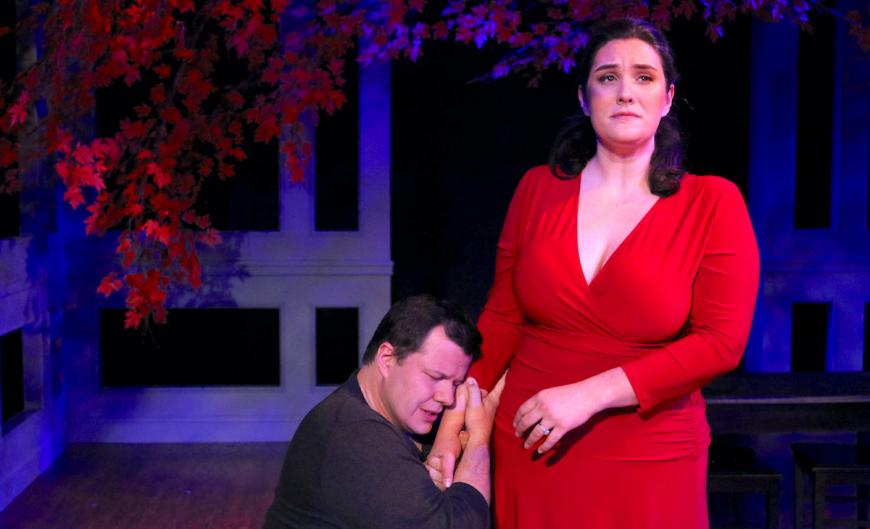
Is it hard to capture live performance on a budget?
Oh yeah, the cameraman has to get the right angle; if someone stands up, their head has to stay in shot and the sound designer has to mic the room so that we don’t hear clomping footsteps. The work is done in the room but then the real project begins, which is that you have all this stuff and how do you piece together what is in the final post-edit? And we always have backups and backups.
Our artists are so mature. Efraín [Solís] blows me away, every day. Vanessa [Becerra] has something about her that you can’t take your eyes off her, and Eugene [Brancoveanu] has sung in every kind of theater and every kind of role and Ashley Dixon — I don’t know if you’ve heard her sing, but this is one of the most important voices of her generation. Everyone shut down, so we have had the best of the best and I don’t want to go back to competing with the Met and Houston Grand Opera to keep my artists. I’ve been very spoiled this year.
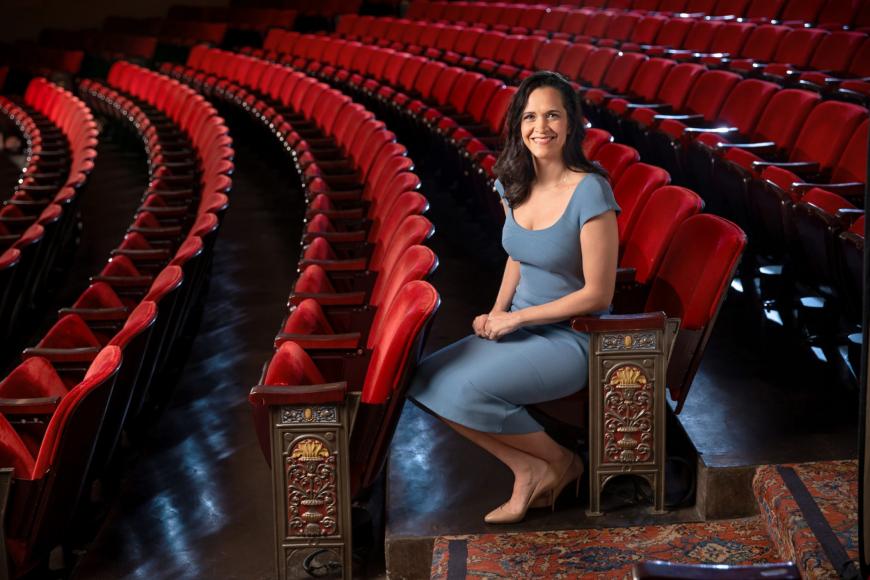
What did you learn about being a TV producer?
I’ve learned that decisions get made earlier. When I’m producing something for the stage, I can show up at the final dress and say, “That doesn’t work, we’re changing it.” If I wait that long now, the cake is already baked. It was challenging for me to navigate, not wanting to squelch the creative team’s early process but still be able to say, “Oh no, we need to change course before it’s too late,” and I think that’s something I’m still working on.
I was naïve about the number of people who would engage with our content. I thought a larger number of people would be open to this, but I think there has been such a wave of stuff online that it’s overwhelming and the cost of marketing something in the digital space is a hundred times more. Our donors have been standing by us, but many of them don’t want to watch. I was naïve about how much you have to hustle for every click and every view. But I also undervalued our production team; they’ve had to adapt their entire artform to the camera. All of a sudden, the props have to be real, they can’t just look real, and the hair can’t just be a wig. And it’s only now that we’ve gone through this that I really do bow down to those people for their ability to pivot and continue to produce at such a high level. It’s a steep learning curve and we’re just at the beginning of it.




